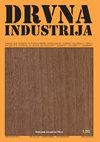制浆工艺和能耗对麦秸纳米纤化木质纤维素膜性能的影响
IF 0.8
4区 农林科学
Q4 MATERIALS SCIENCE, PAPER & WOOD
引用次数: 2
摘要
目前的研究主要集中在纳米原纤化木质纤维素(NFLC)的生产上,而不是纳米原纤纤维素(NFC),后者可以用更少的能源生产,预计将具有与NFC类似的用途,特别是在透明度不重要的行业。此外,还调查了NFLC生产所需的能源消耗的影响以及制浆方法对生产的NFLC性能的影响。通过机械精炼和微流控器中的不同通道,结果表明,NFLC的平均直径从19000nm左右下降到36nm。在精炼机和微流器中,在给定的能耗下,与MEA相比,Soda NFLC膜具有更高的卡尺和更低的粗糙度。对于这两种纸浆,在三次通过微流器的情况下,达到NFLC薄膜最佳拉伸指数的最佳能耗水平为258kWh/t。通过次数和压力的更多增加只导致能量消耗的增加,而对提高拉伸指数没有任何积极影响。苏打法和MEA法制备的NFLC膜的最大拉伸指数分别为113.5和119.86N·m/g。通过微流器5次,获得了8.5kP·m2/g的爆裂指数和458kWh/t的能耗。随着苏打和MEA样品通过微流控器的次数的增加,不透明度降低,但透明度增加。本文章由计算机程序翻译,如有差异,请以英文原文为准。
The Influence of Pulping Process and Energy Consumption on Properties of Nanofibrillated Lignocellulose (NFLC) Films Isolated from Wheat Straw
The present research has primarily focused on the production of nanofibrillated lignocellulose (NFLC) instead of nanofibrillated cellulose (NFC), which could be produced with less energy and is expected to have similar uses as NFC, especially in the sectors where the transparency is not important. Furthermore, the effect of energy consumption needed for NFLC production and also the influence of pulping methods on the produced NFLC properties has been surveyed. Through mechanical refining and different passes in microfluidizer, the results showed the average diameter of NFLC declined from around 19000 nm to 36 nm. Soda-NFLC films had higher calliper and lower roughness, compared to those of MEA at given energy consumption in refiner and microfluidizer. For both kinds of pulps, the optimum level of energy consumption to reach the best tensile index of NFLC films was 258 kWh/t, with three passes through microfluidizer. More increase in the number of passes and pressure only resulted in increasing of energy consumption without any positive effect on improving the tensile index. The maximum tensile indices of NFLC films obtained from soda and MEA pulping processes were 113.5 and 119.86 N·m/g, respectively. The burst index of 8.5 kP·m2/g and the energy consumption of 458 kWh/t were obtained for five passes through microfluidizer. With the increase of the number of passes of soda and MEA samples through microfluidizer, the opacity decreased but transparency increased.
求助全文
通过发布文献求助,成功后即可免费获取论文全文。
去求助
来源期刊

Drvna Industrija
MATERIALS SCIENCE, PAPER & WOOD-
CiteScore
1.80
自引率
9.10%
发文量
32
审稿时长
>12 weeks
期刊介绍:
"Drvna industrija" ("Wood Industry") journal publishes original scientific and review papers, short notes, professional papers, conference papers, reports, professional information, bibliographical and survey articles and general notes relating to the forestry exploitation, biology, chemistry, physics and technology of wood, pulp and paper and wood components, including production, management and marketing aspects in the woodworking industry.
 求助内容:
求助内容: 应助结果提醒方式:
应助结果提醒方式:


